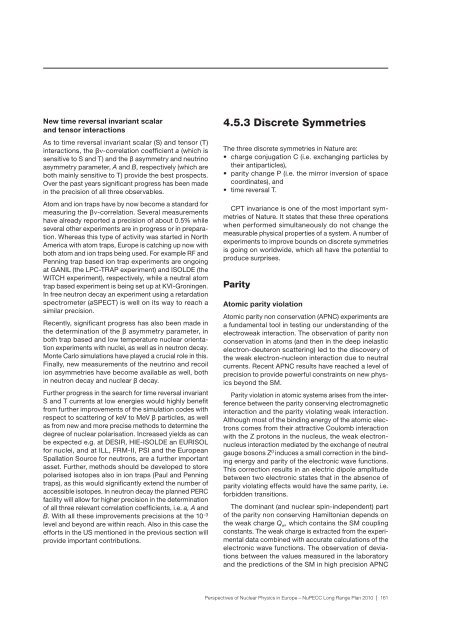Perspectives of Nuclear Physics in Europe - European Science ...
Perspectives of Nuclear Physics in Europe - European Science ...
Perspectives of Nuclear Physics in Europe - European Science ...
Create successful ePaper yourself
Turn your PDF publications into a flip-book with our unique Google optimized e-Paper software.
New time reversal <strong>in</strong>variant scalar<br />
and tensor <strong>in</strong>teractions<br />
As to time reversal <strong>in</strong>variant scalar (S) and tensor (T)<br />
<strong>in</strong>teractions, the βν-correlation coefficient a (which is<br />
sensitive to S and T) and the β asymmetry and neutr<strong>in</strong>o<br />
asymmetry parameter, A and B, respectively (which are<br />
both ma<strong>in</strong>ly sensitive to T) provide the best prospects.<br />
Over the past years significant progress has been made<br />
<strong>in</strong> the precision <strong>of</strong> all three observables.<br />
Atom and ion traps have by now become a standard for<br />
measur<strong>in</strong>g the βν-correlation. Several measurements<br />
have already reported a precision <strong>of</strong> about 0.5% while<br />
several other experiments are <strong>in</strong> progress or <strong>in</strong> preparation.<br />
Whereas this type <strong>of</strong> activity was started <strong>in</strong> North<br />
America with atom traps, <strong>Europe</strong> is catch<strong>in</strong>g up now with<br />
both atom and ion traps be<strong>in</strong>g used. For example RF and<br />
Penn<strong>in</strong>g trap based ion trap experiments are ongo<strong>in</strong>g<br />
at GANIL (the LPC-TRAP experiment) and ISOLDE (the<br />
WITCH experiment), respectively, while a neutral atom<br />
trap based experiment is be<strong>in</strong>g set up at KVI-Gron<strong>in</strong>gen.<br />
In free neutron decay an experiment us<strong>in</strong>g a retardation<br />
spectrometer (aSPECT) is well on its way to reach a<br />
similar precision.<br />
Recently, significant progress has also been made <strong>in</strong><br />
the determ<strong>in</strong>ation <strong>of</strong> the β asymmetry parameter, <strong>in</strong><br />
both trap based and low temperature nuclear orientation<br />
experiments with nuclei, as well as <strong>in</strong> neutron decay.<br />
Monte Carlo simulations have played a crucial role <strong>in</strong> this.<br />
F<strong>in</strong>ally, new measurements <strong>of</strong> the neutr<strong>in</strong>o and recoil<br />
ion asymmetries have become available as well, both<br />
<strong>in</strong> neutron decay and nuclear β decay.<br />
Further progress <strong>in</strong> the search for time reversal <strong>in</strong>variant<br />
S and T currents at low energies would highly benefit<br />
from further improvements <strong>of</strong> the simulation codes with<br />
respect to scatter<strong>in</strong>g <strong>of</strong> keV to MeV β particles, as well<br />
as from new and more precise methods to determ<strong>in</strong>e the<br />
degree <strong>of</strong> nuclear polarisation. Increased yields as can<br />
be expected e.g. at DESIR, HIE-ISOLDE an EURISOL<br />
for nuclei, and at ILL, FRM-II, PSI and the <strong>Europe</strong>an<br />
Spallation Source for neutrons, are a further important<br />
asset. Further, methods should be developed to store<br />
polarised isotopes also <strong>in</strong> ion traps (Paul and Penn<strong>in</strong>g<br />
traps), as this would significantly extend the number <strong>of</strong><br />
accessible isotopes. In neutron decay the planned PERC<br />
facility will allow for higher precision <strong>in</strong> the determ<strong>in</strong>ation<br />
<strong>of</strong> all three relevant correlation coefficients, i.e. a, A and<br />
B. With all these improvements precisions at the 10 -3<br />
level and beyond are with<strong>in</strong> reach. Also <strong>in</strong> this case the<br />
efforts <strong>in</strong> the US mentioned <strong>in</strong> the previous section will<br />
provide important contributions.<br />
4.5.3 Discrete Symmetries<br />
The three discrete symmetries <strong>in</strong> Nature are:<br />
• charge conjugation C (i.e. exchang<strong>in</strong>g particles by<br />
their antiparticles),<br />
• parity change P (i.e. the mirror <strong>in</strong>version <strong>of</strong> space<br />
coord<strong>in</strong>ates), and<br />
• time reversal T.<br />
CPT <strong>in</strong>variance is one <strong>of</strong> the most important symmetries<br />
<strong>of</strong> Nature. It states that these three operations<br />
when performed simultaneously do not change the<br />
measurable physical properties <strong>of</strong> a system. A number <strong>of</strong><br />
experiments to improve bounds on discrete symmetries<br />
is go<strong>in</strong>g on worldwide, which all have the potential to<br />
produce surprises.<br />
Parity<br />
Atomic parity violation<br />
Atomic parity non conservation (APNC) experiments are<br />
a fundamental tool <strong>in</strong> test<strong>in</strong>g our understand<strong>in</strong>g <strong>of</strong> the<br />
electroweak <strong>in</strong>teraction. The observation <strong>of</strong> parity non<br />
conservation <strong>in</strong> atoms (and then <strong>in</strong> the deep <strong>in</strong>elastic<br />
electron-deuteron scatter<strong>in</strong>g) led to the discovery <strong>of</strong><br />
the weak electron-nucleon <strong>in</strong>teraction due to neutral<br />
currents. Recent APNC results have reached a level <strong>of</strong><br />
precision to provide powerful constra<strong>in</strong>ts on new physics<br />
beyond the SM.<br />
Parity violation <strong>in</strong> atomic systems arises from the <strong>in</strong>terference<br />
between the parity conserv<strong>in</strong>g electromagnetic<br />
<strong>in</strong>teraction and the parity violat<strong>in</strong>g weak <strong>in</strong>teraction.<br />
Although most <strong>of</strong> the b<strong>in</strong>d<strong>in</strong>g energy <strong>of</strong> the atomic electrons<br />
comes from their attractive Coulomb <strong>in</strong>teraction<br />
with the Z protons <strong>in</strong> the nucleus, the weak electronnucleus<br />
<strong>in</strong>teraction mediated by the exchange <strong>of</strong> neutral<br />
gauge bosons Z 0 <strong>in</strong>duces a small correction <strong>in</strong> the b<strong>in</strong>d<strong>in</strong>g<br />
energy and parity <strong>of</strong> the electronic wave functions.<br />
This correction results <strong>in</strong> an electric dipole amplitude<br />
between two electronic states that <strong>in</strong> the absence <strong>of</strong><br />
parity violat<strong>in</strong>g effects would have the same parity, i.e.<br />
forbidden transitions.<br />
The dom<strong>in</strong>ant (and nuclear sp<strong>in</strong>-<strong>in</strong>dependent) part<br />
<strong>of</strong> the parity non conserv<strong>in</strong>g Hamiltonian depends on<br />
the weak charge Q w , which conta<strong>in</strong>s the SM coupl<strong>in</strong>g<br />
constants. The weak charge is extracted from the experimental<br />
data comb<strong>in</strong>ed with accurate calculations <strong>of</strong> the<br />
electronic wave functions. The observation <strong>of</strong> deviations<br />
between the values measured <strong>in</strong> the laboratory<br />
and the predictions <strong>of</strong> the SM <strong>in</strong> high precision APNC<br />
<strong>Perspectives</strong> <strong>of</strong> <strong>Nuclear</strong> <strong>Physics</strong> <strong>in</strong> <strong>Europe</strong> – NuPECC Long Range Plan 2010 | 161
















